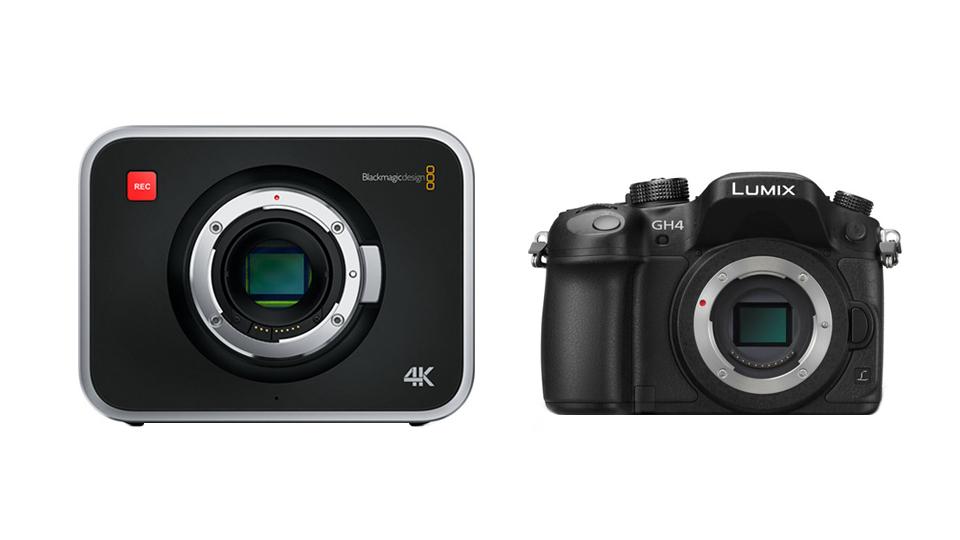Even though it’s only been shipping for a short time, the Blackmagic Production Camera 4K is the current “go-to” choice for shooting 4K video with a single sensor/interchangeable-lens system for less than $4000. However, things may change when Panasonic ships their 4K-capable Lumix GH4. If you’re in the market for a sub-$4,000 4K camera, how do you choose? Rather than conducting a head-to-head shootout, this post is about clarifying what the specs mean to you.
Are you looking at specs only? Good luck with that. Although both cameras have a lot to offer, hitting a relatively low price point has affected the design choices of both models.?Essentially, it all comes down to how you shoot, or, as the British say, ¡°…horses for courses.¡± Are you looking for a still camera that also shoots 4K video? Or are you looking for a 4K camera that has a larger sensor than the Micro Four Thirds format, and is strictly for shooting 4K and HD video, not stills? If your primary use is shooting stills, and sensor size isn¡¯t an issue, then your choice is easy, because the GH4 is the clear winner. However, if you’re primarily interested in shooting video, and not concerned with shooting stills, this is where things get a little tougher.
Sensor Size/Lens Mount
The Blackmagic Production Camera 4K features a Super 35mm-sized sensor and an electronic Canon EF mount, while the GH4 features a Micro Four Thirds-sized sensor and a?Micro Four Thirds mount. How much difference sensor size makes is up to you, but it does bear discussing. Sensor size has more to do with sensitivity, lens choice, and focal-length perspective. So instead of focusing on the size of the sensor, think about the lens mount. The Blackmagic camera uses a mount that accepts?Canon EF lenses. Although there are many lenses available in the EF mount, as of the writing of this article, there is no simple or inexpensive option for using PL-mount glass on that camera. In comparison, the Micro Four Thirds mount on the GH4 will permit you to use a wider range of lenses, including PL and Canon EF-mount lenses, among many others. If you want to use non-EF-mount lenses, or if you want the option to use almost any lens, at this point, you should be looking at the GH4.
Workflow
If you need a camera that fits into a more professional workflow, with 6G-SDI ports and Thunderbolt output, then the Blackmagic camera is probably more your speed than the GH4, which comes with an HDMI output. Professional ports don’t come cheap, as the Blackmagic Production Camera 4K is priced just shy of $3,000, while the GH4 is less than $1,700. However, Panasonic is releasing the DMW-YAGH camera-mounting adapter box for nearly $2,000, which adds dual XLR inputs, 3G-SDI outputs, and Quad Link SDI outputs. The adapter, which costs more than the camera itself, allows the GH4 to fit into a traditional production workflow. The added XLR inputs and audio level meters create an audio solution that the Blackmagic camera lacks.
Audio capabilities may not be an issue for you, especially if you work with a sound recordist who mixes the audio before recording it into the camera and/or to an external recorder. As far as the Blackmagic¡¯s lack of XLR inputs goes, I checked with Antonio Arroyo, a New York-based location sound professional, who told me that,?not withstanding the Blackmagic camera’s preamps, the ?¡± TRS connectors themselves aren¡¯t a problem. The only issue is making sure that you have adapters from XLR to ?¡± TRS, and there are a plethora of adapters available.¡±
Resolution and Bit Depth
“Don¡¯t look for one camera to be the best; look for the camera that’s going to fit the way you shoot.”
Here are a few more points to consider as you decide which option best fits your needs. The Blackmagic Production Camera 4K records UHD (3840 x 2160) and 1080p video only, while the GH4 shoots 4096 x2160, as well as UHD, and 1080p. The difference between 4096 x 2160 and 3840 x 2160 is a small one, with 4096 being the cinema standard for 4K, while UHD is the 16 x 9 equivalent. So, if you’re shooting for the cinema, you want to check out how much, if any, of a headache the non-cinema resolution is going to cause you. The Blackmagic also records 12-bit video to a removable internal SSD. The Panasonic can only record 8-bit internally, to SD cards. 10-bit video is supposed to be available from the GH4 via the HDMI output (or SDI output by using the DMW-YAGH adapter). This means if you want the highest quality from the GH4, you need an external recorder, as opposed to recording to an internal SSD with the the Blackmagic. Generally speaking, the higher the bit-depth, the greater the control in post production; however, the file sizes are larger too.
Wrapping it up
Looking at each of these cameras, it¡¯s amazing that you can get 4K for the price. The GH4 is both more and less expensive than the Blackmagic Production Camera 4K, which really gives you three cameras to choose from, not two. Each camera will have its own strong points and weaknesses. Don¡¯t look for one camera to be the best; look for the camera that’s going to fit the way you shoot.


